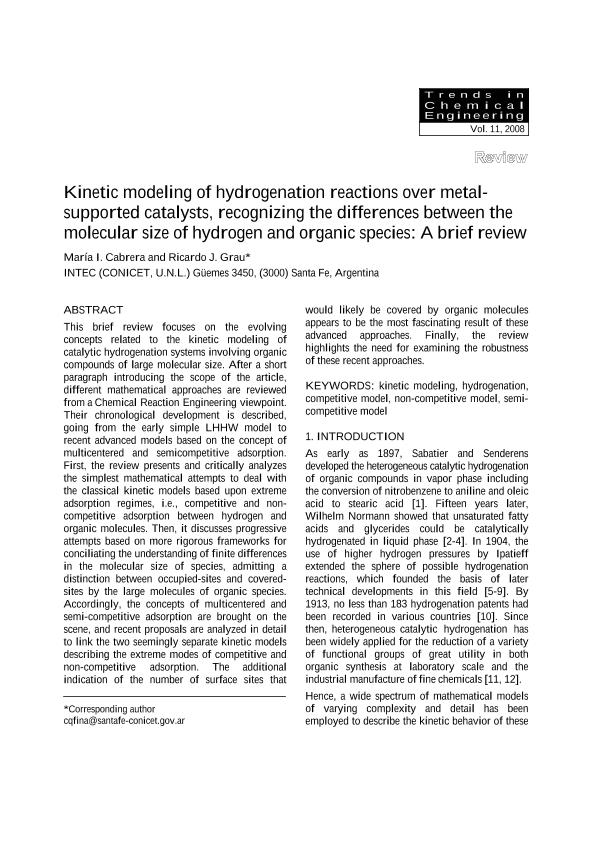Mostrar el registro sencillo del ítem
dc.contributor.author
Cabrera, Maria Ines

dc.contributor.author
Grau, Ricardo José Antonio

dc.date.available
2017-09-28T20:03:26Z
dc.date.issued
2008-08
dc.identifier.citation
Cabrera, Maria Ines; Grau, Ricardo José Antonio; Kinetic Modeling of Hydrogenation Reactions over Metal-Supported Catalysts, Recognizing the Differences Between the Molecular Sizes of Hydrogen and Organic Species: A Brief Review; Research Trends; Trends in Chemical Engineering; 11; 8-2008; 39-53
dc.identifier.issn
0972-4478
dc.identifier.uri
http://hdl.handle.net/11336/25376
dc.description.abstract
This brief review focuses on the evolving concepts related to the kinetic modeling of catalytic hydrogenation systems involving organic compounds of large molecular size. After a short paragraph introducing the scope of the article, different mathematical approaches are reviewed from a Chemical Reaction Engineering viewpoint. Their chronological development is described, going from the early simple LHHW model to recent advanced models based on the concept of multicentered and semicompetitive adsorption. First, the review presents and critically analyzes the simplest mathematical attempts to deal with the classical kinetic models based upon extreme adsorption regimes, i.e., competitive and non-competitive adsorption between hydrogen and organic molecules. Then, it discusses progressive attempts based on more rigorous frameworks for conciliating the understanding of finite differences in the molecular size of species, admitting a distinction between occupied-sites and covered-sites by the large molecules of organic species. Accordingly, the concepts of multicentered and semi-competitive adsorption are brought on the scene, and recent proposals are analyzed in detail to link the two seemingly separate kinetic models describing the extreme modes of competitive and non-competitive adsorption. The additional indication of the number of surface sites that would likely be covered by organic molecules appears to be the most fascinating result of these advanced approaches. Finally, the review highlights the need for examining the robustness of these recent approaches.
dc.format
application/pdf
dc.language.iso
deu
dc.publisher
Research Trends
dc.rights
info:eu-repo/semantics/openAccess
dc.rights.uri
https://creativecommons.org/licenses/by-nc-sa/2.5/ar/
dc.subject
Kinetic Modeling
dc.subject
Hydrogenation Competitive Model
dc.subject
Non-Competitive Model
dc.subject
Semicompetitive Model
dc.subject.classification
Otras Ingeniería Química

dc.subject.classification
Ingeniería Química

dc.subject.classification
INGENIERÍAS Y TECNOLOGÍAS

dc.title
Kinetic Modeling of Hydrogenation Reactions over Metal-Supported Catalysts, Recognizing the Differences Between the Molecular Sizes of Hydrogen and Organic Species: A Brief Review
dc.type
info:eu-repo/semantics/article
dc.type
info:ar-repo/semantics/artículo
dc.type
info:eu-repo/semantics/publishedVersion
dc.date.updated
2017-09-25T18:20:59Z
dc.journal.volume
11
dc.journal.pagination
39-53
dc.journal.pais
India

dc.description.fil
Fil: Cabrera, Maria Ines. Consejo Nacional de Investigaciones Científicas y Técnicas. Centro Científico Tecnológico Conicet - Santa Fe. Instituto de Desarrollo Tecnológico para la Industria Química. Universidad Nacional del Litoral. Instituto de Desarrollo Tecnológico para la Industria Química; Argentina
dc.description.fil
Fil: Grau, Ricardo José Antonio. Consejo Nacional de Investigaciones Científicas y Técnicas. Centro Científico Tecnológico Conicet - Santa Fe. Instituto de Desarrollo Tecnológico para la Industria Química. Universidad Nacional del Litoral. Instituto de Desarrollo Tecnológico para la Industria Química; Argentina
dc.journal.title
Trends in Chemical Engineering
dc.relation.alternativeid
info:eu-repo/semantics/altIdentifier/url/http://www.researchtrends.net/tia/abstract.asp?in=0&vn=11&tid=1&aid=2512&pub=2008&type=3
Archivos asociados
